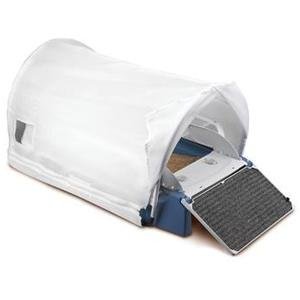Litterpan Problems in Cats

Litterpan problems are very common in cats. It helps to think about this problem from the cat's point of view sometimes when trying to deal with it. Cats like to have a clean, inviting place to defecate and urinate. It is very important to make the litterbox as attractive as possible for use.
Pictured to the right is the Kitty Kabana which gives your cat sufficient privacy.
Keep the litterbox very clean. Use a litter that the cat likes. The clumping type litters are the most commonly preferred litters in surveys of cat preference. If you are not using this type and your cat has a problem, it can help to switch.
The litterpan should be in a convenient, but private or at least semi-private site.
It helps very much to have one more litterpan than you have cats. In multicat households where this is impractical, it can help to give the problem cat access to the litterpan, alone, for several minutes twice a day.
When a cat is using a place in the house other than the litterpan to urinate or defecate, the opposite is also true. You want to make these spots unattractive. Cleaning the area with an enzymatic cleaner so the cat is not drawn back to the same site helps. Putting plastic or aluminum foil over the area, if possible, can be very helpful. Putting the litterpan at the site the cat prefers, then very gradually moving it to a site you like can be helpful.
Some cats are not using the litterpan because they are marking territory. This can occur in either male or female cats. It is more common in cats in multi-cat households, especially if there are five or more cats. It can occur when an inside cat is bothered by frequent appearances of an outside cat at the windows. In this case, limiting access to seeing the other cat can help. If a cat is not neutered, this should be done first.
Neutering is often helpful, even after urine marking (spraying) behavior is established. Currently, it is estimated that 80 to 90% of cats will stop urine marking within a couple of months after neutering. When neutering alone does not work, urine marking behavior is often responsive to medical therapy with medications like diazepam (Valium) or buspirone (Buspar).
Labels: Cat Litter Problems



0 Comments:
Post a Comment
Subscribe to Post Comments [Atom]
<< Home